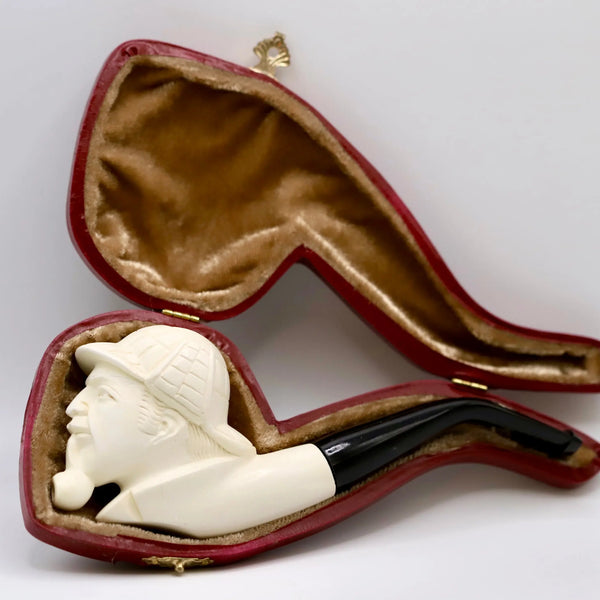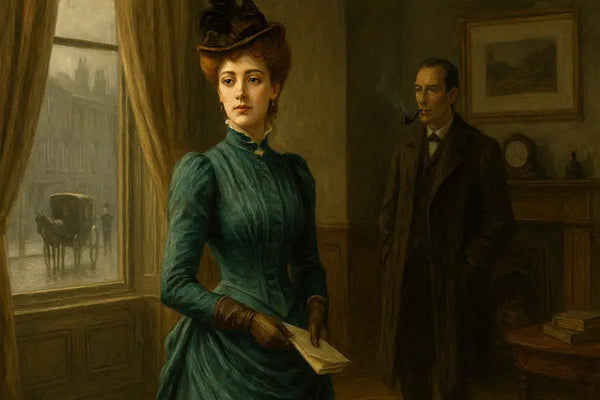Three years after the creator of Sherlock Holmes introduced the world’s most famous consulting detective, Arthur Conan Doyle, whose influence on detective fiction is profound, returned with The Sign of Four, a novel that would fundamentally transform the dynamics of his fictional universe.
Published in 1890, this second entry in what would become the four novels of the Sherlock Holmes canon brought profound changes to the relationship between Holmes and Watson whilst introducing themes of romance, colonial guilt, and social justice that would resonate throughout Victorian literature. The Sign of Four stands as more than merely another case for the master detective—it is a classic Sherlock Holmes novel and a foundational work in crime fiction. It represents the moment when Conan Doyle’s creation truly evolved from experimental character study to sophisticated exploration of Victorian society’s complexities.
Over time, the character of Holmes has continued to evolve, but it is Doyle's stories that have set the standard for detective fiction and shaped the genre. The adventures of Sherlock Holmes, including The Sign of Four, are essential parts of the broader collection of Sherlock Holmes stories, showcasing the detective's methods and the enduring appeal of Conan Doyle's literary legacy.
Summary
• Character Development Revolution: The Sign of Four transforms the Holmes-Watson dynamic by introducing Mary Morstan, a very attractive woman who becomes Watson’s romantic interest whilst serving as the catalyst for one of Holmes’s most complex cases, highlighting the exceptional skills and reputation of the great detective.
• Social Commentary Through Mystery: Arthur Conan Doyle uses the strange mystery of the Agra treasure, the missing treasure at the heart of the story, to explore themes of colonial exploitation, class disparity, and the treatment of London’s poor in Victorian society.
• Scientific Detective Evolution: Holmes’s methods become more sophisticated, showcasing his development as a scientific detective through detailed forensic analysis and psychological profiling of criminals like Jonathan Small, and demonstrating how he handles so delicate a matter with scientific precision.
• Atmospheric Victorian Storytelling: The novel creates its own proper atmosphere through vivid descriptions of Victorian London, from the yellow fog swirls of the Thames to the contrasts between wealth and poverty.
Publication History and Context
The success of “A Study in Scarlet,” though initially modest, had demonstrated the potential of Sherlock Holmes as a literary character. By 1889, American publisher J.M. Stoddart was actively seeking new material for Lippincott’s Magazine, and Conan Doyle found himself commissioned alongside Oscar Wilde to produce novellas for the publication. This commission would prove pivotal not only for the Holmes canon but for detective fiction generally.
The Sign of Four appeared in the February 1890 issue of Lippincott’s Magazine, reaching both British and American audiences simultaneously. This international publication marked Holmes’s first major exposure to American readers, beginning the character’s global expansion that would make him one of literature’s most recognisable figures.
Conan Doyle approached this second Holmes adventure with greater confidence than his debut effort. Having established the basic character dynamics and investigative methods in “A Study in Scarlet,” he could now focus on expanding the emotional and social dimensions of his fictional world. The result was a more sophisticated narrative that balanced mystery, romance, and social commentary with the deductive brilliance that defined Holmes’s appeal.
Contemporary reviews were notably more positive than those greeting “A Study in Scarlet.” Critics praised the novel’s atmospheric descriptions of London and its integration of adventure story elements with detective methodology. The romantic subplot between Watson and Mary Morstan was particularly well-received, with reviewers noting how it humanised the somewhat clinical detective partnership of the first novel. Some critics also made off hand reference to the novel's romantic subplot or adventure elements, highlighting their casual yet notable presence in the narrative.
The publication also marked Conan Doyle’s growing awareness of his creation’s potential longevity. Unlike “A Study in Scarlet,” which he had written quickly and sold outright, The Sign of Four was crafted with greater attention to character development and thematic depth, suggesting that he was beginning to view Holmes as more than merely a temporary literary experiment.
The novel’s success encouraged Conan Doyle to consider Holmes as a potentially ongoing character, though he had not yet conceived the short story format that would make the detective truly famous. This transitional position gives The Sign of Four unique significance as the bridge between Holmes’s experimental origins and his eventual status as a cultural phenomenon.
Plot Structure and Narrative Innovation
The Sign of Four employs a sophisticated dual narrative structure that demonstrates Conan Doyle’s maturing storytelling abilities. The novel divides into two distinct but interconnected parts: the contemporary London mystery and the historical Indian backstory, each serving different narrative functions whilst contributing to the overall thematic unity.
Part One introduces Miss Mary Morstan, a young lady who approaches Holmes and Watson at their famous lodgings with a perplexing case. Her father, Captain Morstan, disappeared nearly a quarter of a century ago, and since then she has been receiving valuable pearls anonymously each year. The mystery deepens when she receives an invitation to meet her unknown benefactor, leading to the discovery of Bartholomew Sholto’s murder and the theft of the Great Agra Treasure.
This contemporary narrative showcases Holmes’s evolving detective methods whilst developing the romantic relationship between Watson and Mary Morstan. The pacing builds steadily from the initial consultation through the investigation of the Sholto household to the dramatic Thames chase sequence that concludes this section.
Part Two shifts dramatically in both narrative voice and temporal setting, as Jonathan Small recounts his story of the Great Indian Mutiny, the formation of the “sign of the four” conspiracy, and his subsequent imprisonment and escape. The 'sign of the four' is a cryptic clue, a hieroglyphic symbol central to the mystery, linking the conspirators and the events surrounding the Agra Treasure. This historical narrative provides crucial context for understanding the contemporary mystery whilst exploring themes of colonial exploitation and moral ambiguity.
The structural innovation lies in how Conan Doyle integrates these two narratives without sacrificing the momentum of either. Unlike “A Study in Scarlet,” where the American section feels somewhat disconnected from the London mystery, The Sign of Four maintains thematic and emotional coherence throughout both parts. The historical section enhances rather than interrupts the contemporary story, providing moral complexity that enriches the overall narrative.
This dual structure also allows Conan Doyle to explore different narrative voices. Watson’s first-person narration dominates the contemporary sections, whilst Small’s confession provides a different perspective that adds variety without confusing the overall narrative flow. This technique would influence numerous subsequent adventure and detective novels that sought to balance immediate mystery with historical explanation.
Character Analysis and Development
The Sign of Four represents a watershed moment in character development for the Holmes series, introducing romantic elements that would fundamentally alter the dynamic between the two protagonists whilst deepening our understanding of Holmes’s personality and methods.
Mary Morstan emerges as far more than simply a romantic interest for Watson. Conan Doyle presents her as a young woman wronged and seeking justice for her father’s disappearance, but her character develops beyond this initial victimisation. Throughout the investigation, Miss Morstan demonstrates remarkable composure and intelligence, never becoming merely a passive object of male protection.
Her relationship with Watson evolves naturally from professional consultation to personal attraction. Conan Doyle handles their courtship with considerable subtlety, showing Watson’s growing feelings through small observations and protective instincts rather than dramatic declarations. Mary Morstan’s response is equally nuanced—she appreciates Watson’s attention whilst maintaining her independence and dignity.
Significantly, Mary Morstan’s presence affects the Holmes-Watson partnership in complex ways. Watson finds himself torn between loyalty to Holmes and attraction to this most winning woman, creating internal conflict that adds psychological depth to his character. The novel suggests that Watson’s eventual marriage will change his relationship with Holmes, introducing themes of personal growth and changing priorities that would influence subsequent stories.
Dr John Watson undergoes his most significant character development in this novel. The romantic subplot reveals dimensions of his personality barely glimpsed in “A Study in Scarlet.” His attraction to the young woman awakens emotions that contrast sharply with the clinical detachment he usually maintains during investigations. As Dr Watson reflects on his experiences, he often feels a slight feeling of uncertainty and introspection, especially when balancing his loyalty to Holmes and his growing affection for Mary Morstan.
Watson’s medical background becomes more prominent as he tends to various injuries throughout the case, establishing his professional competence whilst showing how his skills complement Holmes’s detective abilities. The novel also reveals his capacity for decisive action during the Thames chase, demonstrating courage and initiative that make him a more equal partner to Holmes. Watson’s weak leg, a lingering result of his war injury, is referenced as part of his background, highlighting his vulnerability and adding depth to his character.
The development of Dr Watson’s romantic feelings creates internal monologues that provide insight into his thought processes and emotional state. These passages humanise him considerably, showing a man capable of deep feeling beneath his professional demeanour. His struggle between duty to Holmes and attraction to Mary adds psychological complexity that enriches the entire narrative.
Sherlock Holmes appears in this novel at a crucial transitional moment in his development as a character. The famous opening scene reveals him injecting a seven percent solution of cocaine, establishing the drug use that reflects his need for intellectual stimulation during periods of professional inactivity. “Hence the cocaine,” he explains to Watson, demonstrating his logical approach to personal chemistry as well as criminal investigation.
Holmes’s detective methods show significant advancement from the first novel. His forensic analysis becomes more sophisticated, employing detailed observation of physical evidence combined with psychological profiling of suspects. The scientific detective emerges more fully formed, using chemical analysis, anthropological knowledge, and systematic reasoning to solve the case. Holmes is particularly adept at evaluating people based on their personal qualities rather than superficial appearances, allowing him to make objective assessments. He also consciously disregards emotional qualities in his investigations, believing that emotions can cloud judgment and hinder logical reasoning.
The romantic subplot reveals Holmes’s emotional limitations alongside his intellectual superiority. His complete indifference to Mary Morstan’s charms and his dismissive attitude towards Watson’s romantic feelings demonstrate his isolation from normal human emotions. This characterisation establishes the pattern of Holmes as a brilliant but emotionally stunted individual that would define him throughout the canon.
Holmes’s relationship with Jonathan Small shows his capacity for understanding criminal psychology whilst maintaining moral judgment. His respectful treatment of Small during the confession scenes suggests intellectual appreciation for the man’s circumstances without condoning his criminal actions.
Jonathan Small represents one of Conan Doyle’s most complex antagonists, a man whose criminal actions stem from understandable grievances rather than simple evil. His partnership with the Andaman Islander Tonga and his wooden-legged condition make him physically distinctive whilst his moral justifications for pursuing the treasure create psychological complexity.
Small’s backstory during the Indian Mutiny reveals him as a victim of circumstances who made increasingly desperate choices to survive. His transformation from honest soldier to treasure hunter to murderer follows a logical progression that makes him sympathetic despite his crimes. This moral ambiguity would become characteristic of Conan Doyle’s better villains.
The Sholto Family plays a pivotal role in the unfolding mystery. The rivalry and tension between Thaddeus Sholto and his twin brother Bartholomew are central to the plot, especially regarding the hidden treasure and the secrets surrounding their father’s legacy. Twin brother Bartholomew’s involvement adds another layer of intrigue and familial conflict, emphasizing the complexity of the case Holmes and Dr Watson must unravel.
Victorian London and Social Themes
The Sign of Four showcases Conan Doyle’s mastery of atmospheric description, using Victorian London’s physical environment to reflect and enhance the novel’s thematic concerns. The city becomes almost a character itself, with its contrasts between wealth and poverty, civilization and savagery, providing crucial context for the mystery’s resolution.
At night, shop windows streamed light onto the foggy streets, casting vivid patterns that mingled with the feeble circular glimmer of street lamps struggling through the thick London mist. The Thames features prominently as both setting and symbol, representing the commercial arteries that brought wealth from the Empire whilst hiding the moral costs of that prosperity. The river chase sequence transforms London’s waterways into a dramatic stage for the conflict between justice and vengeance, with the mud-coloured clouds and yellow fog swirls creating an appropriately murky atmosphere for the pursuit.
Conan Doyle’s descriptions of different London neighbourhoods reveal sharp social distinctions that reflect the novel’s thematic concerns with inequality and exploitation. The contrast between the Sholto mansion in affluent Norwood and the poverty of the East End districts creates visual representation of the social divisions that the Agra treasure’s history embodies on a global scale.
The treatment of the London poor appears throughout the novel, most notably through the Baker Street Irregulars who assist in tracking Jonathan Small. These street children represent the marginalised populations whose labour supports the Empire’s wealth whilst receiving little benefit themselves. Their eager cooperation with Holmes for minimal payment reflects the economic desperation that characterised working-class life in Victorian London.
The novel’s colonial themes emerge through the treasure’s Indian origins and the backstory of the Great Mutiny. Conan Doyle presents the Indian Rebellion as a complex event with legitimate grievances on both sides, whilst acknowledging the moral compromises required for imperial administration. Jonathan Small’s participation in both the military suppression and the subsequent treasure theft embodies the moral ambiguity of colonial service.
The character of Tonga, the Andaman Islander, reflects Victorian attitudes towards racial difference whilst serving specific narrative functions. His exotic appearance and savage behaviour conform to contemporary stereotypes, yet his loyalty to Small suggests more complex motivations than simple barbarism. This characterisation reveals both the prejudices of Conan Doyle’s era and his attempt to create dramatic tension through exotic elements. The Sholto household, shaped by years of secrecy and fear, is particularly suspicious of outsiders—especially those with wooden legs, a prejudice rooted in the mysterious events of the family's past.
Women’s roles receive significant attention through Mary Morstan’s character, who represents progressive Victorian ideals of female capability whilst remaining within acceptable social boundaries. Her economic independence through her work as a governess and her intelligent participation in the investigation suggest changing attitudes towards women’s social roles, though she ultimately finds fulfillment through marriage to Watson.
Detective Methods and Scientific Innovation
The Sign of Four demonstrates Holmes’s evolution as a scientific detective, showcasing investigative techniques that were revolutionary for Victorian fiction whilst establishing methodologies that would influence real-world criminal investigation. This novel presents Holmes at his most systematic, applying scientific principles to criminal detection with unprecedented rigour.
Holmes’s forensic analysis reaches new levels of sophistication in this case. His examination of the Sholto crime scene reveals attention to minute physical details that contemporary police would have overlooked. The analysis of footprints, both human and canine, demonstrates his ability to extract maximum information from minimal evidence. Before an examination, Holmes is often seen adjusting his left shirt cuff, a small but telling gesture that highlights his meticulousness.
The chemical analysis of poisons and the anthropological assessment of Tonga’s dart show Holmes applying specialised scientific knowledge to criminal investigation. These techniques reflect contemporary advances in forensic science whilst demonstrating how intellectual preparation enhances observational skills. Holmes’s knowledge base appears encyclopaedic yet practical, always directed towards solving specific investigative problems. When preparing his tools, Holmes retrieves his hypodermic syringe from a neat Morocco case, handling the medical instruments with nervous fingers that belie his composed precision.
The art of logical reasoning reaches its most refined expression in this novel. Holmes’s deductions about Mary Morstan’s background, his analysis of the Sholto brothers’ characters, and his predictions about Jonathan Small’s behaviour all demonstrate systematic thinking that transforms scattered observations into coherent theories. In moments of introspection, Holmes makes use of his syringe with clinical precision, carefully driving the sharp point home. The sharp point of the needle, handled with exactness, underscores his methodical approach even in his personal habits.
The novel also shows Holmes’s understanding of criminal psychology, particularly in his assessment of Jonathan Small’s motivations and likely actions. His ability to predict where Small might go and how he might behave reflects not just logical reasoning but intuitive understanding of human nature under extreme circumstances.
The introduction of more sophisticated investigative tools, including the use of a steam launch for the Thames pursuit and the employment of the Baker Street Irregulars as an intelligence network, shows Holmes developing systematic approaches to practical detection challenges. These innovations suggest a professional level of organisation that goes beyond amateur enthusiasm.
Literary Themes and Symbolism
The Sign of Four operates on multiple thematic levels, using the treasure hunt narrative to explore profound questions about justice, morality, and the costs of imperial expansion. The novel’s symbolic structure supports these themes whilst maintaining the surface excitement of an adventure story.
The Agra treasure itself functions as the central symbol around which all the novel’s themes revolve. Originally plundered during the chaos of the Indian Mutiny, the treasure represents the moral compromises inherent in colonial rule. Its subsequent theft by the “sign of four” conspiracy demonstrates how imperial violence creates cycles of exploitation that corrupt all participants. The valuable pearl, received annually by Miss Morstan, stands as both a symbol of wealth and the enduring mystery that propels the narrative.
The “sign of four” as a symbol represents brotherhood corrupted by greed and circumstances. The original compact between Small, the Sholto brothers, and Dost Akbar was formed from mutual dependence during dangerous circumstances, yet it ultimately becomes a source of betrayal and murder. This transformation reflects the novel’s broader theme about how extreme circumstances can corrupt even well-intentioned relationships. Holmes, in his investigations, interprets evidence in such a way as to reveal hidden truths that others overlook, demonstrating his unique deductive approach.
Holmes’s cocaine use symbolises the intellectual’s struggle with mundane reality. His need for artificial stimulation during periods of professional inactivity reflects the challenge faced by exceptional minds in ordinary circumstances. The seven percent solution becomes both escape mechanism and self-medication, suggesting the costs of intellectual superiority. Watson’s recounting of Holmes’s adventures sometimes includes humorous anecdotes, such as the double barrelled tiger cub, which serve to illustrate the detective’s eccentricity and the lighter moments within the otherwise tense mystery.
The romantic relationship between Watson and Mary Morstan represents the possibility of personal happiness despite the moral complexity surrounding them. Their love story develops against the backdrop of murder and colonial exploitation, yet it offers hope for individual redemption and normal human connection.
The Thames setting symbolises both connection and division, serving as the pathway that brings exotic dangers to London whilst representing the commercial networks that sustain imperial prosperity. The river’s murky waters reflect the moral ambiguity that pervades the entire narrative.
Justice versus revenge emerges as a central thematic concern through Jonathan Small’s character. His pursuit of the treasure can be interpreted as either legitimate recovery of stolen property or criminal vengeance, depending on one’s perspective on the original circumstances. The novel suggests that clear moral judgments become difficult when colonial violence complicates traditional notions of right and wrong.
Language and Narrative Style
Conan Doyle’s prose style shows marked development in The Sign of Four, demonstrating greater confidence in atmospheric description and character development whilst maintaining the clear, direct narrative voice that makes Holmes stories accessible to broad audiences. The novel’s language reflects Victorian literary conventions whilst incorporating innovations that would influence subsequent detective fiction.
Watson’s narrative voice becomes more sophisticated in this novel, showing greater psychological insight and emotional range than in “A Study in Scarlet.” His descriptions of Mary Morstan reveal developing literary skills whilst his accounts of the investigation maintain the clinical precision that makes him an effective chronicler of Holmes’s methods.
The dialogue shows particular improvement, with conversations between Holmes and Watson achieving natural rhythm that reveals character whilst advancing plot. Holmes’s speeches often take on a somewhat dogmatic tone when asserting his theories, demonstrating his intellectual superiority without becoming pedantic, whilst Watson’s responses show intelligence and loyalty without mere sycophancy. Frequently, Sherlock explains his reasoning to Watson, providing detailed insight into his deductive process.
Atmospheric writing reaches new heights in this novel, particularly in the descriptions of London’s fog-shrouded streets and the murky Thames waters. Conan Doyle’s use of weather and environment to reflect emotional states and moral ambiguity demonstrates sophisticated understanding of literary technique.
The integration of technical vocabulary reflects Conan Doyle’s medical background whilst making scientific detection accessible to general readers. Holmes’s explanations of forensic techniques use precise terminology without becoming incomprehensible, establishing the template for scientific exposition in detective fiction. Holmes’s eyes rested thoughtfully on each piece of evidence, emphasizing his deep concentration and introspective approach to deduction.
The novel’s handling of violence shows restraint that enhances rather than diminishes dramatic impact. Descriptions of murder and injury focus on their emotional and moral significance rather than graphic detail, maintaining the story’s focus on intellectual rather than sensational appeal.
Reception and Critical Analysis
The Sign of Four received considerably more positive critical attention than its predecessor, with contemporary reviewers praising both its narrative sophistication and its atmospheric evocation of London. Critics also lauded the novel as a classic Sherlock Holmes story, highlighting its enduring appeal within detective fiction. The novel’s success helped establish Holmes as a viable ongoing character whilst demonstrating Conan Doyle’s potential as a serious writer of popular fiction.
Victorian critics particularly appreciated the novel’s integration of romance with mystery, noting how the Watson-Morstan relationship added emotional depth without interfering with the detective plot. The romantic subplot was seen as making the stories more appealing to female readers whilst maintaining the intellectual appeal that attracted male audiences.
The exotic elements—particularly the Indian Mutiny backstory and Tonga’s character—received mixed reviews that reflected contemporary attitudes towards imperial adventure fiction. Some critics praised the novel’s scope and ambition, whilst others questioned the appropriateness of such sensational elements in detective fiction.
Among the novel’s most memorable characters is Jonathan Small, the wooden legged man, whose physical traits and actions play a central role in the unfolding mystery. Academic analysis of the novel has focused increasingly on its colonial themes and their reflection of Victorian imperial attitudes. Modern scholars have examined how the novel both reinforces and questions contemporary assumptions about racial difference and imperial justice, finding complexity that early reviewers missed.
The novel’s position within the complete Sherlock Holmes canon has been extensively debated, with some critics arguing that it represents the series’ emotional peak due to its successful integration of personal and professional concerns. Others contend that the romantic subplot weakens the intellectual purity that defines Holmes’s appeal. Supporting characters such as Athelney Jones, the diligent Scotland Yard inspector, are often discussed for their contributions to the investigation and their dynamic with Holmes and Watson.
Feminist literary criticism has paid particular attention to Mary Morstan’s character, noting both progressive elements in her portrayal and the limitations imposed by Victorian gender conventions. Her role as both active participant and romantic object reflects the contradictions inherent in Victorian attitudes towards women’s capabilities.
Adaptations and Cultural Legacy
The Sign of Four has inspired numerous adaptations across different media, though perhaps fewer than some other Holmes stories due to its romantic subplot and complex colonial themes. Each adaptation has reflected its era’s attitudes towards empire, romance, and detective fiction whilst attempting to capture the novel’s distinctive atmosphere. Compared to adaptations of the Sherlock Holmes short stories, which often focus on concise plots and character-driven mysteries, adaptations of The Sign of Four tend to grapple more with its layered themes and extended narrative.
Early stage adaptations focused primarily on the treasure hunt adventure, often minimising the romantic elements and simplifying the colonial backstory. These versions emphasised action and spectacle over character development, reflecting early 20th-century preferences for straightforward entertainment over moral complexity.
Radio adaptations proved particularly successful at capturing the novel’s atmospheric qualities, using sound effects and music to evoke the fog-shrouded Thames and the exotic elements of the Indian backstory. The medium’s limitations actually enhanced certain aspects of the story by forcing focus on dialogue and character interaction.
Television and film adaptations have varied widely in their treatment of the colonial themes, with some emphasising the adventure elements whilst others attempt to address the moral complexity of imperial exploitation. Modern adaptations often struggle with Tonga’s character, finding contemporary audiences less willing to accept Victorian racial stereotypes.
The romantic subplot has proved challenging for many adaptations, particularly those that prefer to maintain Holmes and Watson as an unattached detective partnership. Some versions eliminate Mary Morstan entirely, whilst others reduce her role to brief romantic interest that doesn’t affect the ongoing series dynamic.
Notable portrayals of Mary Morstan have ranged from passive Victorian heroines to more assertive modern interpretations that emphasise her intelligence and independence. The most successful adaptations find ways to make her character integral to the mystery whilst developing her relationship with Watson naturally, sometimes showing Watson as only slightly involved in certain aspects of the investigation due to his growing affection for Mary.
The novel’s influence on subsequent detective fiction extends beyond direct adaptations to encompass structural innovations and thematic concerns that became standard elements of the genre. The integration of historical backstory with contemporary mystery and the use of exotic elements to enhance domestic crime stories both became common techniques in detective fiction, with the two friends, Holmes and Watson, setting a template for collaborative detective partnerships.
The Novel's Place in the Holmes Canon
The Sign of Four occupies a unique position within the four novels that comprise the Holmes canon’s foundation, serving as the emotional and romantic centre whilst maintaining the intellectual rigour that defines the series. Its introduction of Mary Morstan fundamentally alters the Holmes-Watson dynamic whilst establishing themes that would resonate throughout subsequent adventures.
A key element in the novel is the Sholto family, particularly Major Sholto, a retired officer whose actions and eventual death are central to the history of the missing treasure at the heart of the mystery. His relationship with other characters and the consequences of his choices drive much of the plot and connect the personal and professional stakes for Holmes and Watson.
The novel’s relationship to the fifty-six short stories that would follow is complex, as many of these later tales ignore the married Watson’s changed circumstances whilst drawing on character developments and methodological advances first introduced in this novel. Holmes’s scientific techniques reach mature expression here, providing the foundation for his later investigations.
Within the complete Sherlock Holmes oeuvre, The Sign of Four stands out for its successful integration of personal and professional concerns. Unlike other entries in the canon that focus primarily on intellectual puzzles, this novel demonstrates how detective work affects the investigators’ personal lives whilst maintaining the analytical framework that defines Holmes’s appeal.
The colonial themes that emerge in this novel would appear sporadically throughout later stories, though rarely with the same depth or moral complexity. The novel’s treatment of imperial exploitation and its consequences establishes patterns of moral ambiguity that would characterise Conan Doyle’s best villains and most complex cases.
The romantic resolution that sees Watson married to Mary Morstan creates practical problems for subsequent stories, as the author must either acknowledge the marriage’s impact on the detective partnership or ignore it for narrative convenience. Different stories handle this challenge differently, creating some inconsistency within the broader canon.
Conclusion
The Sign of Four stands as perhaps the most emotionally complete of the Sherlock Holmes novels, successfully balancing intellectual detection with romantic development whilst exploring serious themes about imperial exploitation and social justice. Conan Doyle's second Holmes adventure demonstrates remarkable growth in narrative sophistication whilst maintaining the analytical framework that makes the detective stories intellectually satisfying.
The novel's enduring appeal lies in its successful integration of multiple narrative elements that could easily have conflicted with each other. The treasure hunt adventure, the romantic subplot, the detective investigation, and the colonial moral themes all contribute to a unified narrative that addresses both entertainment and serious literary concerns.
For modern readers, The Sign of Four offers both historical insight into Victorian attitudes towards empire and romance whilst delivering a compelling mystery that remains engaging despite cultural changes. The novel's moral complexity and psychological depth ensure its continued relevance whilst its atmospheric descriptions and memorable characters provide lasting entertainment value.
Within the broader context of detective fiction, The Sign of Four represents a crucial evolutionary step that helped establish many conventions still used in contemporary crime writing. Its influence extends far beyond the Holmes canon to encompass the entire tradition of detective fiction that followed, making it essential reading for understanding how the genre developed its sophisticated approach to character, theme, and social commentary.
Frequently Asked Questions
What is the plot of The Sign of Four by Arthur Conan Doyle?
The Sign of Four follows Mary Morstan as she seeks Holmes's help investigating her father's disappearance and mysterious annual gifts of pearls. The case leads to the murder of Bartholomew Sholto and the theft of the Great Agra Treasure, pursued by Jonathan Small and his exotic companion Tonga. The novel reveals how four men conspired to steal the treasure during the Indian Mutiny, leading to betrayal, murder, and a thrilling chase across Victorian London's Thames.
How does Mary Morstan change Watson's character in The Sign of Four?
Mary Morstan transforms Watson from a purely professional partner into a man capable of deep romantic feelings, creating internal conflict between his loyalty to Holmes and his personal happiness. Her presence reveals Watson's capacity for decisive action, protective instincts, and emotional depth that wasn't apparent in the first novel. Their developing relationship adds psychological complexity to Watson's character whilst establishing his eventual marriage that would affect the entire series dynamic.
What role does the Indian Mutiny play in The Sign of Four?
The Indian Mutiny provides the historical backstory that explains the treasure's origins and Jonathan Small's motivations for pursuing it. Conan Doyle uses the rebellion to explore themes of colonial exploitation and moral ambiguity, showing how imperial violence creates cycles of betrayal and revenge. The Mutiny context gives Small's criminal actions understandable motivation whilst highlighting the moral costs of empire for all participants.
Why does Sherlock Holmes use cocaine in The Sign of Four?
Holmes uses cocaine to combat intellectual boredom during periods without challenging cases, explaining "hence the cocaine" as a logical response to mental understimulation. The seven percent solution represents his need for artificial excitement when his exceptional mind lacks sufficient intellectual engagement. This addiction reveals Holmes's emotional limitations and his struggle to function in ordinary circumstances, adding psychological depth to his character.
How does The Sign of Four differ from A Study in Scarlet?
The Sign of Four shows greater narrative sophistication with smoother integration of contemporary mystery and historical backstory, whilst introducing romantic elements through Mary Morstan that fundamentally change the Holmes-Watson dynamic. Holmes's detective methods become more scientific and systematic, the atmospheric writing improves significantly, and the moral complexity increases through more nuanced treatment of colonial themes and sympathetic villains.
What makes The Sign of Four important in the Sherlock Holmes canon?
The Sign of Four establishes crucial character developments including Watson's romantic life, Holmes's mature detective methods, and the introduction of Mary Morstan who becomes central to the series mythology. It successfully integrates personal and professional concerns whilst exploring serious social themes about empire and justice. The novel bridges Holmes's experimental origins with his eventual cultural icon status, demonstrating the sophisticated storytelling that would define the complete canon.
















































